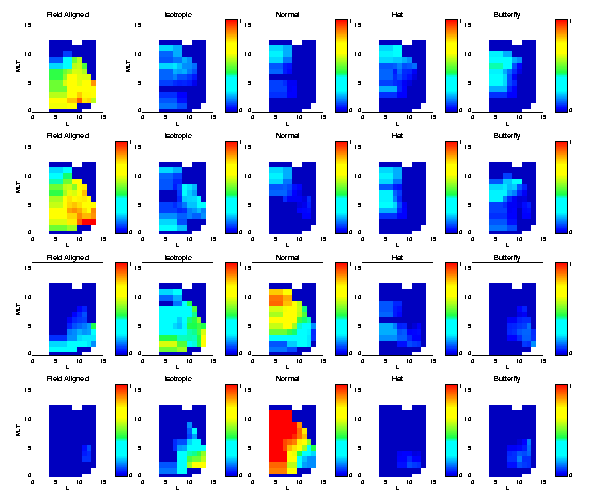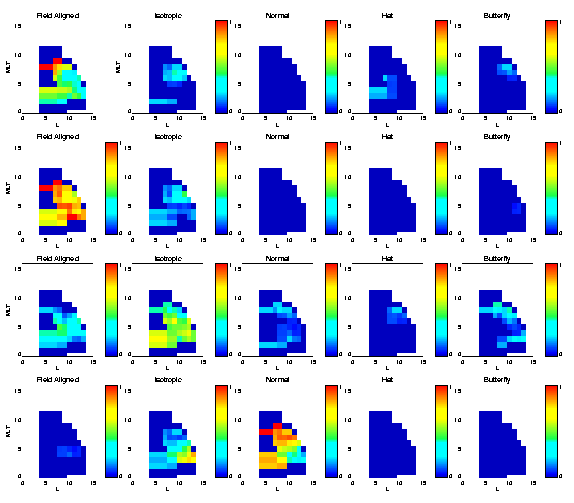Classification of Observed Proton Pitch Angle Distributions
The instument covered the energy range between 20 eV to 40 KeV. We looked at
proton distribution functions from four energy ranges, 20 eV - 100 eV, 100 eV -
1 KeV, 1 KeV - 10 KeV and 10 KeV - 40 KeV. O+, He+ and He++ ions are part of
this project and are yet to be done.
We classified all data according to the seven types of pitch angle
distributions.
For each distribution type we observed we recorded the ephemeris information
(i.e. date/time, L-parameter, local time).
This way we could organize our data as how many times a certain pitch angle
ditribution was observed as a function of Energy range, L-parameter and
local time.
In the plots that follow the five columns correspond to the following five
types: field aligned bidirectional, isotropic, normal, hat and butterfly.
The four rows correspond to the four energy ranges: from top to bottom 20 eV -
100 eV, 100 eV - 1 KeV, 1 KeV - 10 KeV and 10 KeV - 40 KeV.
The satellite did not spend equal time on all L-parameter - local time
regions. This resulted in more events being observed in regions where the
satellite spent most of the time. Therefore we normalized the data by dividing
the number of events observed in a certain L-parameter - local time bin for a
certain distribution type over the total number of events (for all types)
observed in this bin.
ALL
Field aligned bidirectional
-
There are more occurances in the lower energy ranges (10 eV - 1KeV) and at all L and all local times.
- There are less occurances at higher energies and they tend to appear at early local times (0-5 MLT)
Isotropic
- Isotropic distributions are mostly observed at the two higher energy ranges.
- They tend to appear at all L and all local times for energies up to 10 KeV.
- At higher energies (10 KeV - 40 KeV) they appear at high L (>8) and they are concentrated in local times between 1 - 5 MLT.
Normal
- Normal ditributions are mostly observed at the two highest energy ranges
and at all local times and up to L~10.
Hat and Butterfly
- Hat and butterfly distributions are not observed as frequently and they
tend to appear at energies below 10 KeV, up to L~10 and at Local times later
than 3:00 (possibly due to the poor coverage of this local times)
QUIET TIME
-
Data here are taken during quiet periods (Kp index smaller
than 3)
-
The only noticable differences between the "Quiet Time"
chart and the "All" chart appear in the third energy range where:
-
Field aligned distributions appear at high L values fo
local times between 3-5 MLT and at all L for earlier local times (this could
be ralated to the poor statistical coverage at earlylocal times.
-
The butterfly distributions appear only in L~8-12 and 2-5
MLT.
- The data here are taken during disturbed periods. (Kp index greater than
3)
- Events from the disturbed periods represent only the 1/4 of the total
events.
- The concentrations tend to be in the higher L ranges and later local
times.
- Isotropic distributions in the energy range between 1-10 KeV have higher
occurances.
![Proton Pitch Angle Distributions [plot]](Plots/all_distr1.gif)
![Proton Pitch Angle Distributions [plot]](Plots/all_distr1.gif)

